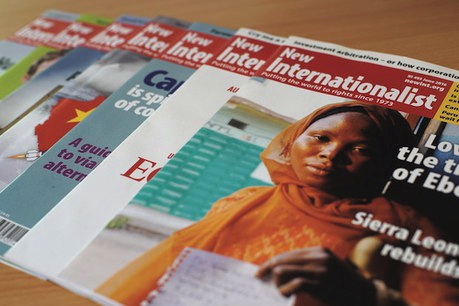Defying the Bush Administration’s neoconservative worldview, El Salvador’s historic Truth Commission Report has once again become a living document.
Published in New Internationalist.
Jon Sobrino is one of the most respected public intellectuals in El Salvador He is also a haunted man. A liberation theologian at the Jesuit University in San Salvador, he was travelling outside the country on the November evening in 1989 when a death squad raided the priests’ residence on campus. Because of the chance scheduling, Sobrino survived. Many of his closest companions—six professors, their cook, and her daughter—were killed.
Massacres. Disappearances. Assassinations. Denial. For a dozen years, El Salvador experienced a civil war in which atrocities like the murder of Sobrino’s fellow Jesuits were covered over by official propaganda. To end the deception, a UN-sponsored Truth Commission, charged with created a definitive retelling of the war’s horrors, became a central component of the peace process that ended the conflict in 1992.
When the commission released its final report, From Madness to Hope: The Twelve-Year War in El Salvador, in March 1993, its findings were stark. The commission vindicated one of the competing versions of events in the war—one that held the Salvadoran armed forces and its paramilitary allies responsible for the vast majority of harrowing abuses. This was the reality already known to the victims and witnesses, the human rights investigators who exhumed bodies in order to document violations, and the wider population that lived in terror. Jon Sobrino claimed that the true author of the report was “the Salvadoran people.”
Recently, however, the truth of El Salvador’s past conflict has again been contested. This time it is not the army or the ruling elite who are attempting to rewrite the country’s history. It is the world’s sole remaining superpower.
While El Salvador has attempted to reconstruct a society based on the history presented by the Truth Commission, the Bush Administration—needing examples of successful US intervention to point to as models for Iraq and Afghanistan—has resurrected a different version of Salvadoran history. A dozen years after its publication, the commission’s report, which for geopolitical purposes might have been filed away in a Cold War historical archive, has again become a charged political document.
In the heat of the 2004 US election campaigns, Vice President Dick Cheney argued in his major televised debate that in the El Salvador of the early 1980s “a guerilla insurgency controlled roughly a third of the country, 75,000 people dead. And we held free elections. I was there as an observer on behalf of the Congress…. And as the terrorists would come in and shoot up polling places as soon as they left, the voters would come back and get in line and would not be denied their right to vote. And today El Salvador is … a lot better because we held free elections.”
The lesson he drew was that elections in Iraq and Afghanistan, while similarly fraught with violence, rested on a viable path to “liberation.” Others, like Defense Secretary Donald Rumsfeld, showed that Cheney’s version of Central American history was not an anomaly but an established part of the neoconservative worldview. On a late-2004 trip to El Salvador, Rumsfeld gratefully acknowledged the Salvadoran army’s participation in the US-led “coalition of the willing” in Iraq, praised the conservative ARENA government (founded by death squad leader Roberto D’Aubuisson), and to noted that the country “understands well the human struggle for liberty and democracy.”
Rumsfeld and Cheney’s perverse reading of history challenges the very premise of a truth commission. Ignoring the report’s findings, the Bush administration resurrects an earlier, ideological rendering of the conflict which, like a photographic negative, transposes light and dark.
Some 75,000 people had been killed in El Salvador. But the Truth Commission charged government military units and death squads with 85 per cent of human rights abuses. (It held rebel FMLN forces responsible for five percent of abuses, with the remaining ten percent undetermined.) The elections that Cheney supervised—where voting was mandatory and dissent perilous—sought to cover the regime with a veneer of democratic respectability. Yet the killing continued through the rest of the decade.
Just days after the Truth Commission report was released, ARENA deputies rushed an amnesty law through the country’s Legislative Assembly pardoning those responsible for abuses.
In the US, Congress commissioned an investigation to determine how the Truth Commission report corresponded with State Department testimony during the 1980s. Despite evidence of massive deception, no perjury charges, reprimands, or official apologies were issued. A decade later, many of the architects of US intervention in El Salvador would receive promotions. (Elliott Abrams, a key public apologist of the Reagan administration’s Central American foreign policy and a convicted Iran-Contra criminal, was recently appointed to serve as deputy national security adviser, responsible for “advancing democracy” abroad.)
These things, to be sure, are evidence that power is its own truth.
Yet, as witnesses to history, the Salvadoran people have made a statement that stands as an indictment. They undertake a type of truth-telling that may yet show itself able to challenge an unchecked superpower. Their report holds forth an assertion that our journalists and public figures regularly show themselves unable or unwilling to muster. It says that the Bush administration’s statements portraying the Salvadoran conflict as a record of benevolent intervention are not legitimate interpretations of the Central American history. Rather, they are lies.
__________
Research assistance for this article provided by Kate Griffiths.
